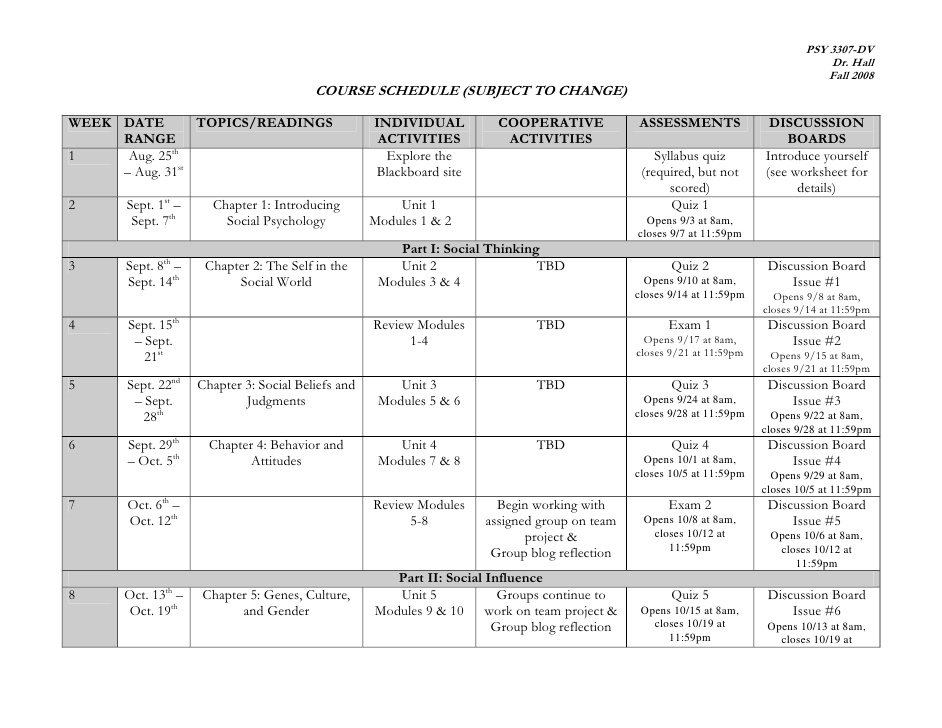An example course syllabus and course schedule has been provided for you. The course syllabus has been specifically created to meet Quality Matters TM standards and follows Kent State University's guidelines for writing syllabi. The syllabus includes both core subjects like Anatomy, Physiology, Nutrition and Genetics, and also comprises additional subjects of courses like English, Computer Science, MBA and Ethics. BSc Nursing is a 4 year long course, mostly divided into 8 semesters. The syllabus of each of these 4 years sets out a different motive in the beginning. Economic geographygeography. A syllabus template is a document which contains the elements, goals, and content of an entire course.Through it, the students find out about the type of learning and teaching they can expect from a class.
Instructor
Jason Beste, MD, MPH

Chenglin Hong, MSW, MPH
Description
This course will provide a general overview to the COVID-19 pandemic. I alex crossebooks free downloads. The lectures series will consist of 6 sessions with each session comprised of a 30-minute lecture. The 6 sessions will encompass the following topics:
- Coronavirus emergence and trajectory;
- Pandemic preparedness and response measures;
- Diagnostics and testing;
- Treatment and vaccine development;
- Personal and institutional prevention; and
- Social and economic impacts.
These sessions will be facilitated by faculty members at the University of Washington who are coronavirus and pandemic preparedness experts and are open to the University of Washington faculty, staff, and students, academic universities, and to the general public.
Learning Objectives
After completing this course, you will be able to:
- Discuss the epidemiology and pathogenesis of COVID-19;
- Explain why COVID-19 became a pandemic and how it spread in Seattle;
- Describe Pandemic Preparedness and Response Measures use in the COVID-19 pandemic;
- Describe the challenges the United States had with the its diagnostic testing;
- Outline testing criteria for COVID-19 and explain how it changed over time;
- Identify treatment options that may be available for COVID-19 that are currently undergoing clinical trials;
- Describe why vaccinations are important and what vaccinations are currently being developed;
- Discuss the prevention measures individuals and institutions can take to prevent the spread the COVID-19; and
- Explain the major social and economic impacts COVID-19 has had both within the United States and around the world.
Course Syllabus Template Word
Format
The sessions are recorded from a live seminar course for University of Washington graduate students. We are making these recordings available to everyone.
We regret we cannot answer individual questions about content. If you have technical questions, please email edghhelp@uw.edu and put covid-19 course in the subject line.
The syllabus page shows a table-oriented view of the course schedule, and the basics ofcourse grading. You can add any other comments, notes, or thoughts you have about the coursestructure, course policies or anything else.
Course Syllabus Template
Ratio and unit rate calculator. To add some comments, click the 'Edit' link at the top.
Course Syllabus Definition
Course Summary:

Chenglin Hong, MSW, MPH
Description
This course will provide a general overview to the COVID-19 pandemic. I alex crossebooks free downloads. The lectures series will consist of 6 sessions with each session comprised of a 30-minute lecture. The 6 sessions will encompass the following topics:
- Coronavirus emergence and trajectory;
- Pandemic preparedness and response measures;
- Diagnostics and testing;
- Treatment and vaccine development;
- Personal and institutional prevention; and
- Social and economic impacts.
These sessions will be facilitated by faculty members at the University of Washington who are coronavirus and pandemic preparedness experts and are open to the University of Washington faculty, staff, and students, academic universities, and to the general public.
Learning Objectives
After completing this course, you will be able to:
- Discuss the epidemiology and pathogenesis of COVID-19;
- Explain why COVID-19 became a pandemic and how it spread in Seattle;
- Describe Pandemic Preparedness and Response Measures use in the COVID-19 pandemic;
- Describe the challenges the United States had with the its diagnostic testing;
- Outline testing criteria for COVID-19 and explain how it changed over time;
- Identify treatment options that may be available for COVID-19 that are currently undergoing clinical trials;
- Describe why vaccinations are important and what vaccinations are currently being developed;
- Discuss the prevention measures individuals and institutions can take to prevent the spread the COVID-19; and
- Explain the major social and economic impacts COVID-19 has had both within the United States and around the world.
Course Syllabus Template Word
Format
The sessions are recorded from a live seminar course for University of Washington graduate students. We are making these recordings available to everyone.
We regret we cannot answer individual questions about content. If you have technical questions, please email edghhelp@uw.edu and put covid-19 course in the subject line.
The syllabus page shows a table-oriented view of the course schedule, and the basics ofcourse grading. You can add any other comments, notes, or thoughts you have about the coursestructure, course policies or anything else.
Course Syllabus Template
Ratio and unit rate calculator. To add some comments, click the 'Edit' link at the top.
Course Syllabus Definition
Course Summary:
| Date | Details |
|---|
